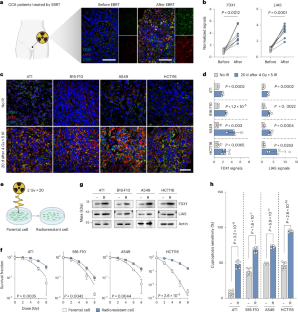A cuproptosis nanocapsule for cancer radiotherapy
IF 38.1
1区 材料科学
Q1 MATERIALS SCIENCE, MULTIDISCIPLINARY
引用次数: 0
Abstract
Residual tumours that persist after radiotherapy often develop acquired radiation resistance, increasing the risk of recurrence and metastasis while providing obstacles to re-irradiation. Using samples from patients and experimental mice, we discovered that FDX1 and LIAS, key regulators of cuproptosis, were up-regulated in residual tumours following radiotherapy, conferring the increased sensitivity to cuproptosis. Therefore, we proposed a novel radiosensitization strategy focused on cuproptosis, using a copper-containing nanocapsule-like polyoxometalate as a paradigm. In an initial demonstration, we showed that the nanocapsule released copper ions in a controlled manner upon exposure to ionizing radiation. Furthermore, radiation-triggered cuproptosis overcame acquired radiation resistance even at clinically relevant radiation doses and activated a robust abscopal effect, with a 40% cure rate in both radioresistant and re-irradiation tumour models. Collectively, targeting cuproptosis is a compelling strategy for addressing acquired radiation resistance, optimizing the local antitumour effects of radiotherapy while simultaneously activating systemic antitumour immunity. Acquired radiation resistance in residual tumours impedes the therapeutic outcome of re-irradiation. This study reports a novel radiosensitization strategy that targets cuproptosis to overcome resistance and enhance antitumour effects.


用于癌症放射治疗的杯突纳米胶囊
放疗后持续存在的残留肿瘤通常会产生获得性放射抗性,增加复发和转移的风险,同时为再次放疗提供障碍。利用患者和实验小鼠的样本,我们发现在放疗后的残留肿瘤中,杯状突变的关键调控因子FDX1和LIAS被上调,从而增加了对杯状突变的敏感性。因此,我们以含铜类纳米胶囊聚氧金属酸盐为范例,提出了一种以杯突症为重点的新型放射增敏策略。在最初的演示中,我们发现纳米胶囊在受到电离辐射时会以可控的方式释放铜离子。此外,即使在临床相关的辐射剂量下,辐射触发的杯突症也能克服获得性辐射抗性,并激活强大的脱落效应,在辐射抗性和再辐射肿瘤模型中的治愈率均达到 40%。总而言之,以杯突症为靶点是解决获得性放射耐药性的一种令人信服的策略,它能优化放疗的局部抗肿瘤效果,同时激活全身抗肿瘤免疫。
本文章由计算机程序翻译,如有差异,请以英文原文为准。
求助全文
约1分钟内获得全文
求助全文
来源期刊

Nature nanotechnology
工程技术-材料科学:综合
CiteScore
59.70
自引率
0.80%
发文量
196
审稿时长
4-8 weeks
期刊介绍:
Nature Nanotechnology is a prestigious journal that publishes high-quality papers in various areas of nanoscience and nanotechnology. The journal focuses on the design, characterization, and production of structures, devices, and systems that manipulate and control materials at atomic, molecular, and macromolecular scales. It encompasses both bottom-up and top-down approaches, as well as their combinations.
Furthermore, Nature Nanotechnology fosters the exchange of ideas among researchers from diverse disciplines such as chemistry, physics, material science, biomedical research, engineering, and more. It promotes collaboration at the forefront of this multidisciplinary field. The journal covers a wide range of topics, from fundamental research in physics, chemistry, and biology, including computational work and simulations, to the development of innovative devices and technologies for various industrial sectors such as information technology, medicine, manufacturing, high-performance materials, energy, and environmental technologies. It includes coverage of organic, inorganic, and hybrid materials.
 求助内容:
求助内容: 应助结果提醒方式:
应助结果提醒方式:


